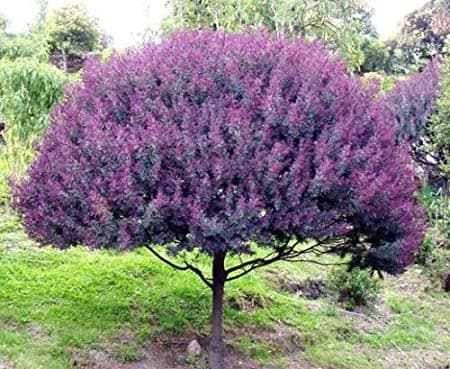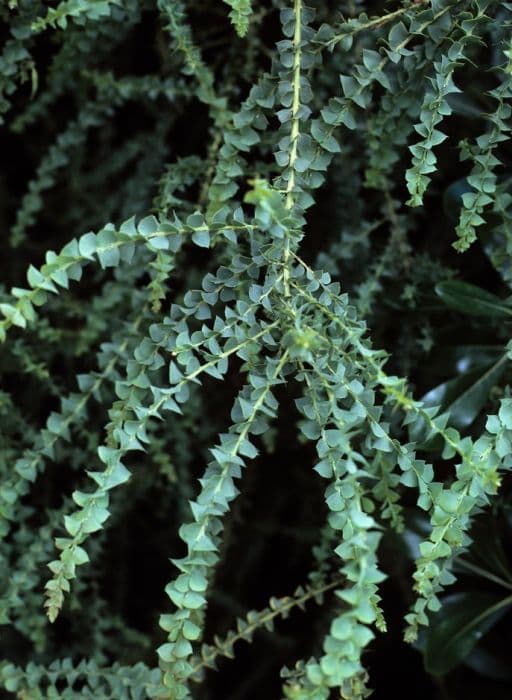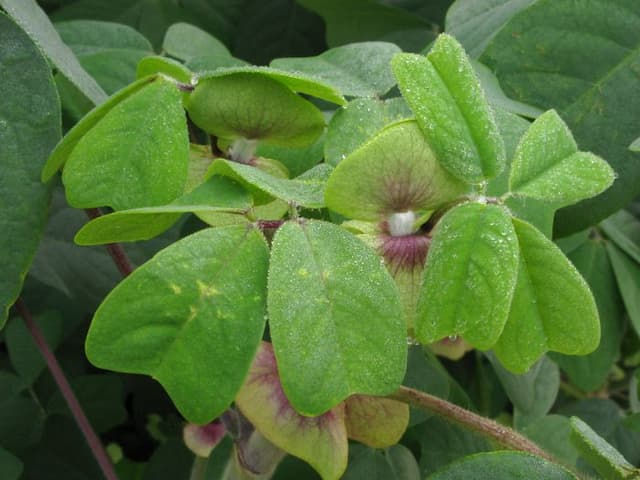Sweet pea Lathyrus odoratus 'Matucana'

ABOUT
The sweet pea 'Matucana' is known for its striking bicolored flowers, which typically showcase a blend of deep, rich purple and a contrasting, vibrant magenta, making them particularly eye-catching. Each flower on this plant is characterized by its elegant, butterfly-like shape and an exquisite, sweet fragrance that is much loved in gardens and cut flower arrangements. The sweet pea 'Matucana' has a climbing habit, utilizing tendrils to grasp onto supports, which allows it to intertwine with structures such as trellises, fences, and obelisks. The flowers form a beautiful display as they cluster on slender, green stems adorned with pairs of leaflets that have a delicate, lance-shaped appearance. The foliage of the sweet pea 'Matucana' is typically light to medium green and provides a soft backdrop that further enhances the visual appeal of the flowers. These engaging blossoms are renowned not only for their visual beauty but also for their ability to attract pollinators such as bees and butterflies to the garden. Overall, the sweet pea 'Matucana' is valued for its aesthetically pleasing flowers and its ability to add vertical interest and delightful scent to any garden setting.
About this plant
 Names
NamesFamily
Fabaceae.
Synonyms
Sweet Pea, Matucana Sweet Pea, Everlasting Pea.
Common names
Lathyrus odoratus 'Matucana'
 Toxicity
ToxicityTo humans
Sweet pea has a low level of toxicity to humans. Symptoms of poisoning from ingestion may include mild to moderate gastrointestinal upset such as nausea, vomiting, and abdominal pain. Large amounts consumed may potentially cause more severe symptoms due to the compound known as beta-aminopropionitrile that sweet pea contains, but such cases are rare.
To pets
Sweet pea is toxic to pets, including cats and dogs. If ingested, it can cause symptoms such as vomiting, weakness, lethargy, seizures, and tremors. The severity of these symptoms can vary, and in some cases, consuming a large amount could potentially lead to more serious health concerns. It is advisable to keep pets away from this plant.
 Characteristics
CharacteristicsLife cycle
Annuals
Foliage type
Deciduous
Color of leaves
Green
Flower color
Mixed
Height
6 feet (1.8 meters)
Spread
1 foot (0.3 meters)
Plant type
Climber
Hardiness zones
2
Native area
Mediterranean
Benefits
 General Benefits
General Benefits- Aesthetic Appeal: Sweet pea 'Matucana' produces striking bicolored flowers that are deep violet and maroon, adding beauty to gardens and landscapes.
- Fragrance: The blooms emit a strong, sweet fragrance that can perfume an entire garden area.
- Attracts Pollinators: The flowers attract bees, butterflies, and other beneficial pollinators, supporting local ecosystems.
- Vertical Interest: With its climbing habit, sweet pea 'Matucana' can add vertical interest to gardens, growing on trellises, fences, or other supports.
- Cut Flowers: The blossoms are long-lasting when cut and are ideal for bouquets and floral arrangements.
- Ease of Growing: This plant is generally easy to grow from seed and can thrive with basic garden care.
- Historical Significance: Being one of the oldest sweet pea cultivars, it offers historical interest for heirloom plant enthusiasts.
 Medical Properties
Medical PropertiesThis plant is not used for medical purposes.
 Air-purifying Qualities
Air-purifying QualitiesThis plant is not specifically known for air purifying qualities.
 Other Uses
Other Uses- Lathyrus odoratus 'Matucana', commonly known as sweet pea, can be used in flower arranging due to its vibrant colors and strong fragrance, enhancing the aesthetic and sensory appeal of bouquets and floral displays.
- The sweet pea is popular in weddings for creating natural, romantic, and fragrant decorative elements, such as table centerpieces or bridal bouquets.
- In crafting, the dried flowers of sweet peas can be incorporated into potpourri mixes, adding a subtle, sweet aroma to rooms.
- Sweet peas can be planted as companions to certain vegetables in gardens, potentially helping to repel specific pests due to their scent.
- The plant's tendrils can be used as a natural art material in weaving small decorative items, such as baskets or wreaths.
- Plant enthusiasts may use sweet pea vines to create living screens or privacy walls in gardens, capitalizing on their climbing nature.
- The vibrant petals of Lathyrus odoratus 'Matucana' can be used as a natural dye source for fabrics, though the color fastness may vary.
- Photographers often use sweet peas as a subject in macro photography to capture the intricate details and texture of the blooms.
- Children can use the hollow stems of sweet peas for fun educational activities, such as making simple plant "straws" to learn about capillary action.
- Gardeners may utilize sweet pea plants as a natural way to improve soil structure, as their roots can help prevent erosion and improve soil stability.
Interesting Facts
 Feng Shui
Feng ShuiThe Sweet pea is not used in Feng Shui practice.
 Zodiac Sign Compitability
Zodiac Sign CompitabilityThe Sweet pea is not used in astrology practice.
 Plant Symbolism
Plant Symbolism- Blissful Pleasure: The sweet pea, with its delightful fragrance, is often associated with experiencing pleasure and enjoying the sweet moments in life.
- Goodbye: In the language of flowers, sweet peas can represent bidding farewell or saying goodbye, possibly due to their fleeting bloom season.
- Delicate Pleasures: The delicate petals and soft scent may symbolize the finer and more subtle joys in life.
- Thankfulness: Giving sweet peas can be a way of expressing gratitude and thanks for a kind gesture or a memorable time.
- Departure: Similar to saying goodbye, sweet peas can symbolize leaving after a positive experience or wishing someone well on a new journey.
 Water
WaterSweet peas, including the 'Matucana' variety, prefer consistent moisture but do not like to be waterlogged. Water them deeply to encourage deep root development once a week, providing about one inch of water each time. During hot spells or dry periods, increase watering frequency to twice a week. Be sure to water at the base of the plant to avoid getting water on the foliage, which can lead to fungal diseases. It's best to check the top inch of soil before watering; if it's dry, it's time to water again.
 Light
LightSweet pea 'Matucana' thrives in full sun, where it receives at least 6 to 8 hours of direct sunlight daily. The best spot for this plant would be in a southern or western exposure, ensuring ample light for vigorous growth and prolific blooming. Avoid planting in full shade, as this will lead to poor flowering and weak, leggy plants.
 Temperature
TemperatureSweet pea 'Matucana' performs best in cool to moderate temperatures, ideally between 55°F and 70°F. They can survive minimum temperatures as low as 25°F but will be damaged by hard freezes. The ideal growing conditions are cool nights and mild daytime temperatures to encourage prolonged blooming. They tend to fade and stop flowering when exposed to excessive heat above 80°F.
 Pruning
PruningPruning sweet pea 'Matucana' encourages bushier growth and more blooms. Pinch out the growing tips when the plants are 4-6 inches tall to stimulate side shoots. Regularly deadhead spent flowers to promote continuous blooming throughout the season. The best time for pruning is in late winter or early spring before new growth begins in earnest.
 Cleaning
CleaningAs needed
 Soil
SoilSweet pea 'Matucana' thrives in well-drained soil mixed with compost and perlite to aid aeration and drainage. The best soil pH for this plant is between 6.0 and 7.5, slightly acidic to neutral.
 Repotting
RepottingSweet pea 'Matucana' is generally sown annually, so repotting is not a common practice. However, if started in containers, transplant when young.
 Humidity & Misting
Humidity & MistingSweet pea 'Matucana' prefers moderate humidity but is adaptable to the humidity levels found in most outdoor garden settings.
 Suitable locations
Suitable locationsIndoor
Ensure plenty of light and support for climbing.
Outdoor
Plant in full sun with support for vines.
Hardiness zone
2-11 USDA
 Life cycle
Life cycleSweet pea 'Matucana' begins its life cycle as seeds that are sown in late winter or early spring. Once germinated, the seedlings develop into young plants with characteristic pinnate leaves and tendrils that seek out support to climb. As the plant matures, it develops strong stems and foliage, and by late spring or early summer, it starts producing fragrant, bicolored purple and deep blue flowers which are attractive to pollinators. After pollination, the flowers develop into legume pods containing several seeds. Throughout the summer, the plant continues to produce flowers and seeds until the weather cools. As autumn approaches, the plant completes its annual cycle by dying back after depositing seeds for the next season's growth.
 Propogation
PropogationPropogation time
Spring
The sweet pea 'Matucana' is a fragrant flowering plant that is commonly propagated by seed. The ideal time to sow sweet pea seeds is in late winter or early spring, allowing them to establish a strong root system before the growing season. The most popular method of propagation for sweet peas involves soaking the seeds for 24 hours in water to soften the hard outer coating. After soaking, sow the seeds about 1 inch deep (2.5 cm) in well-draining soil in pots or directly into the ground where temperatures should be between 55 to 65 degrees Fahrenheit (13 to 18 degrees Celsius) for optimal germination. The seeds usually germinate within 10 to 21 days. Once seedlings become sturdy and frosts have passed, they can be transplanted outdoors, with support to climb as sweet peas are climbing plants. Regular deadheading will encourage continuous blooming throughout the season.









